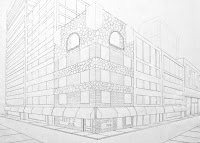Below are some examples of two-point perspective drawings from F100 Basic Drawing. In some cases, very light pencil work was lost in the digitizing process, and some of the camera/lens distortions rendered some verticals less that vertical. However, what is evident in these drawings is an illusion of space created through rules and principles of Linear Perspective, and a grasp of how to utilize those tools. You can click on the drawings for a larger version.
 Jerry's view of a corner pub is loaded with detail and the perspective is effective in communicating the receding spaces down both intersecting streets.
Jerry's view of a corner pub is loaded with detail and the perspective is effective in communicating the receding spaces down both intersecting streets. Jennifer's drawing combines three corners and an abundance of perspective details, cornices, windows, doors, balconies, even a curved glass atrium. The space works very well.
Jennifer's drawing combines three corners and an abundance of perspective details, cornices, windows, doors, balconies, even a curved glass atrium. The space works very well. As I sit here at my MAC writing and loading this post, I am struck by the way that Jason managed to put the apple logo into perspective. It would be fun to see some computers in the windows.
As I sit here at my MAC writing and loading this post, I am struck by the way that Jason managed to put the apple logo into perspective. It would be fun to see some computers in the windows. Dustin has also taken a corner view that sweeps down two streets, yet he manages to keep us on the sidewalks. The perspective is effective in suggesting those spaces.
Dustin has also taken a corner view that sweeps down two streets, yet he manages to keep us on the sidewalks. The perspective is effective in suggesting those spaces. Adam has created a maze of buildings with alleys cutting in and out between them, the brick work on the left adds some interesting spaces to the drawing.
Adam has created a maze of buildings with alleys cutting in and out between them, the brick work on the left adds some interesting spaces to the drawing.The first round of out-of-class projects have been submitted, and we'll talk about them a little this evening so that my written comments, which often aren't legible (so I've been told), will be clear. I want to insure that anyone who wants to resubmit next week will know the direction they need to take.
There were fourteen days from the time the project was first discussed until Tuesday when they were submitted. I also devoted one of our in-class sessions for the planning phase of this out-of-class project. So, if you factor in the amount of out-of-class study required per week for a three credit hour class, my expectations of effort were satisfied if I was looking at a drawing that appeared to exhibit at least nine hours of linear perspective study (drawing). Several satisfied that expectation. According to Greg Roberts, Arts and Letters Academic advisor, for every hour you spend in a class per week, you should devote three hours outside of that class for study. Studio classes are not like regular standard classes, we meet six hours per week instead of three, so I don't expect eighteen hours of study (drawing) per week beyond the six in-class hours, but expecting six hours in a two week period is not unreasonable.
Anyway, we'll hit a few areas of discussion this evening to become more clear about such projects and the efforts needed to be the best we can be in that regard. See you later.

No comments:
Post a Comment